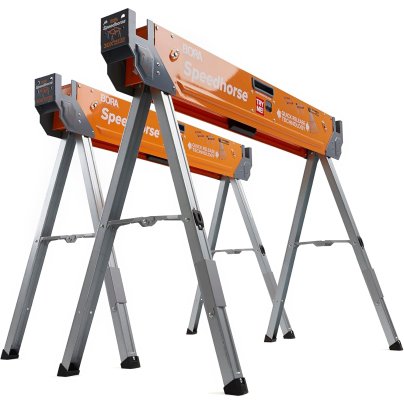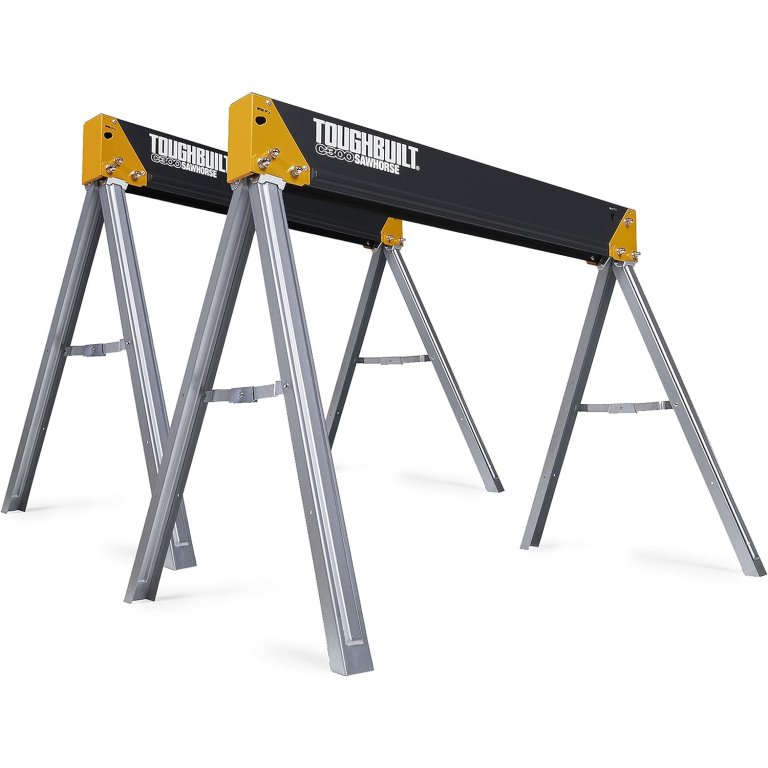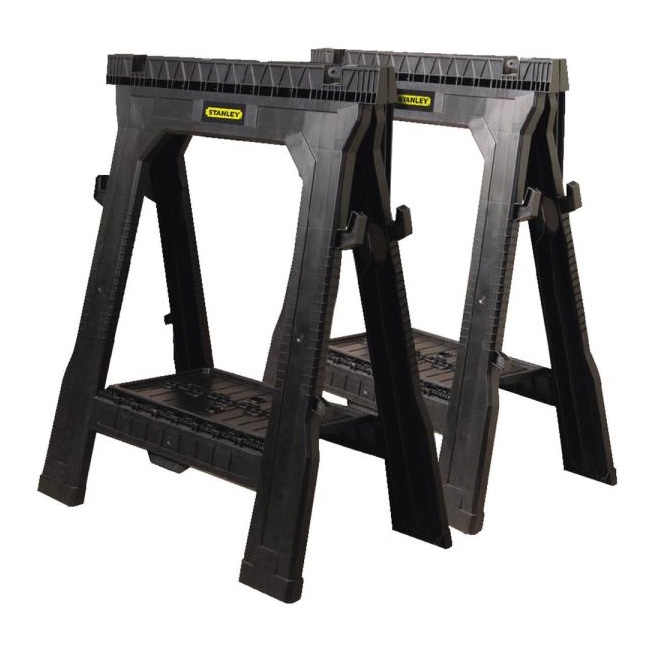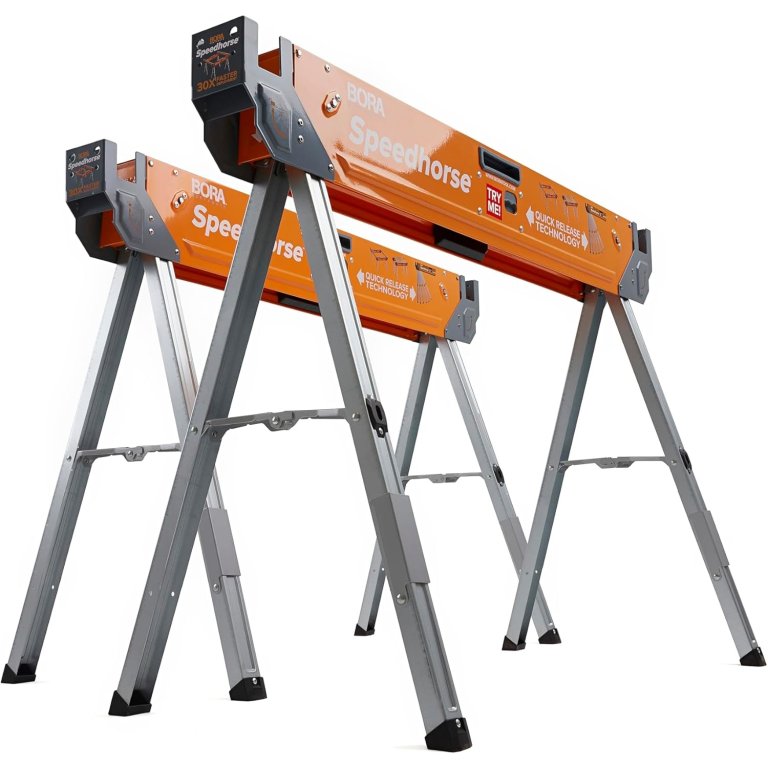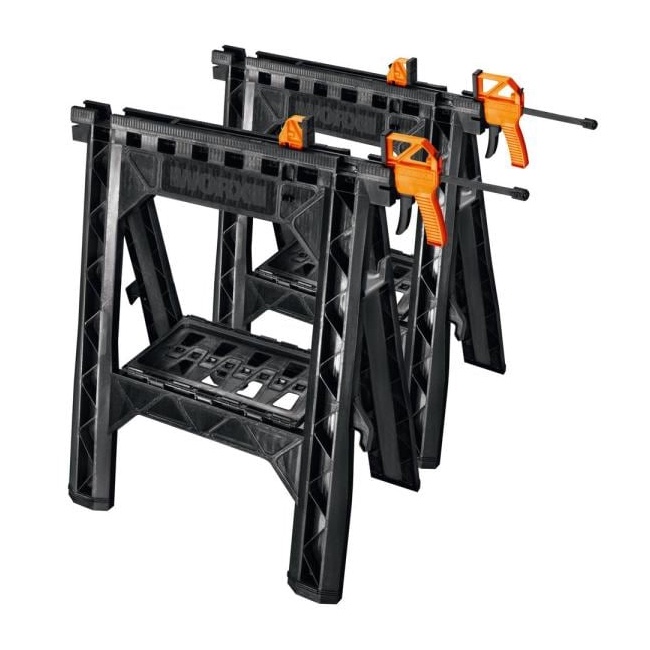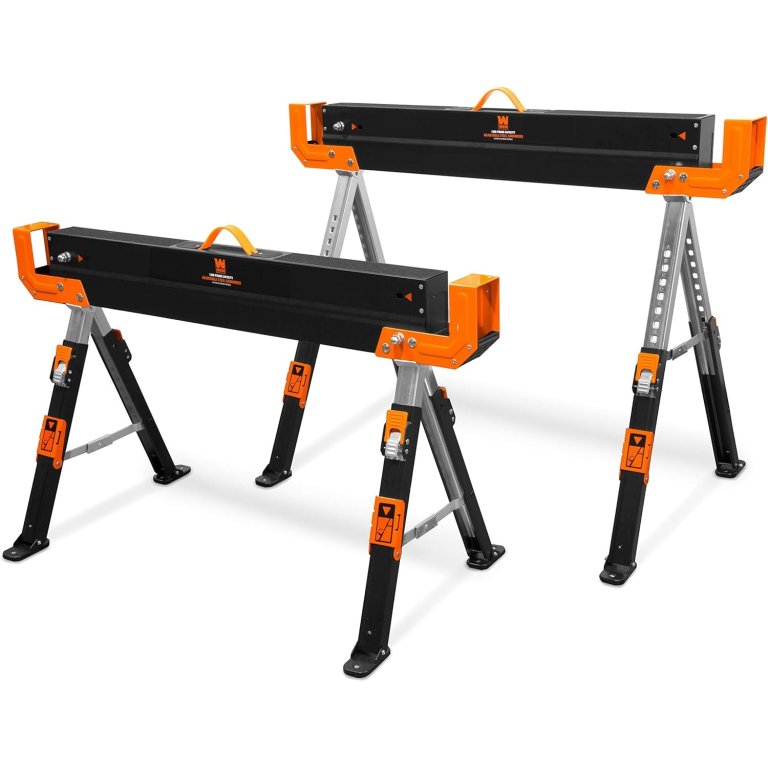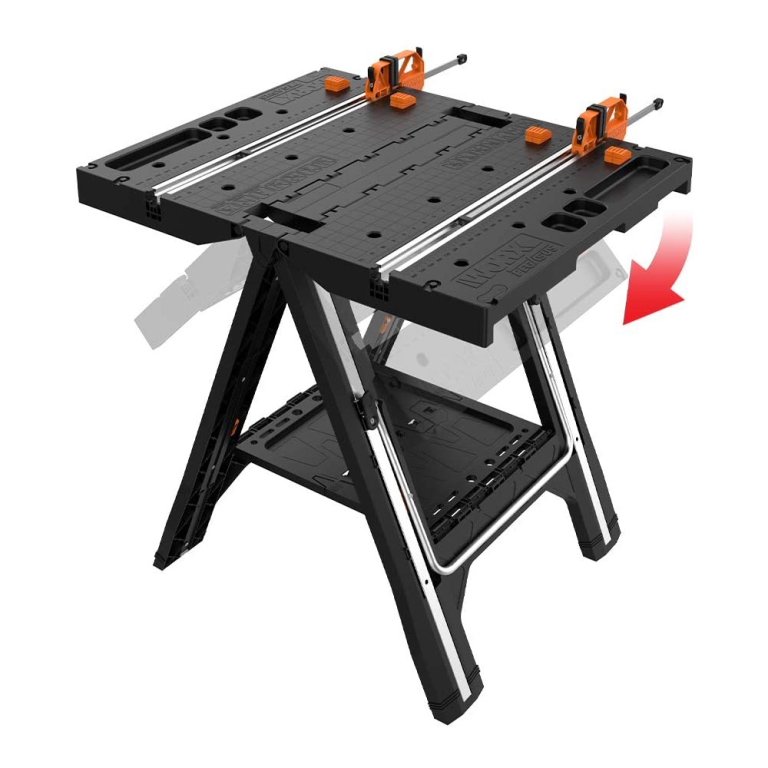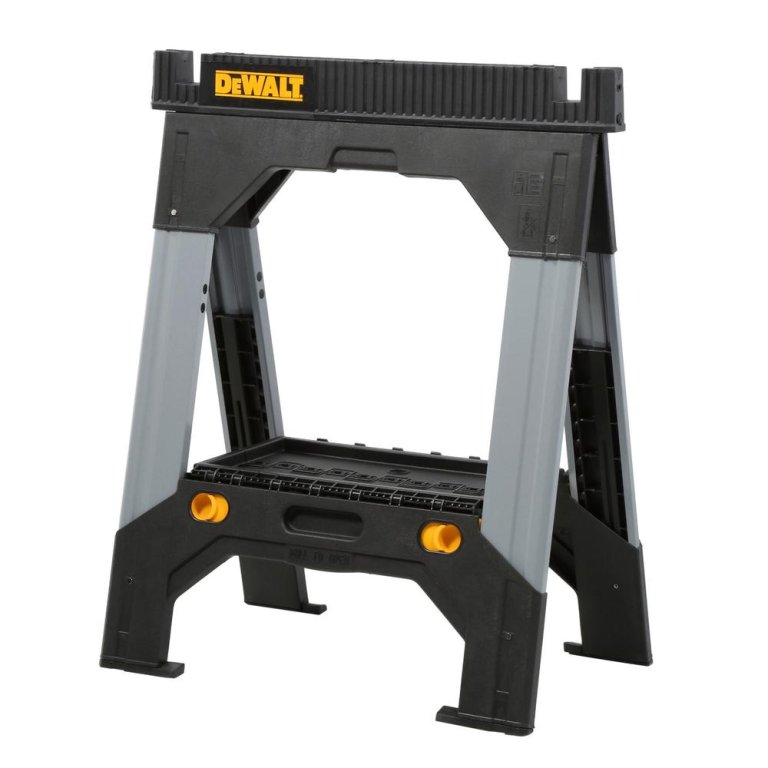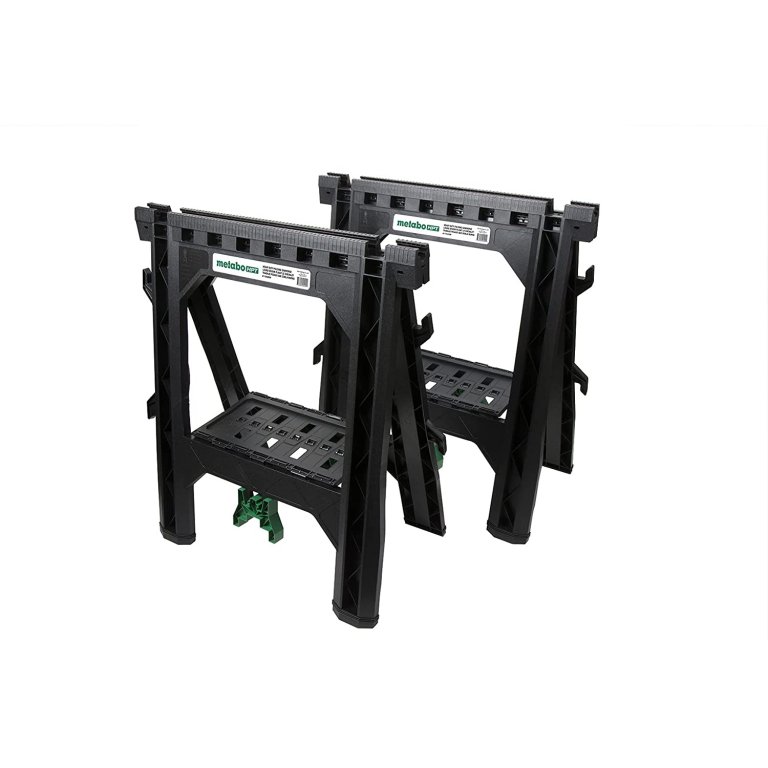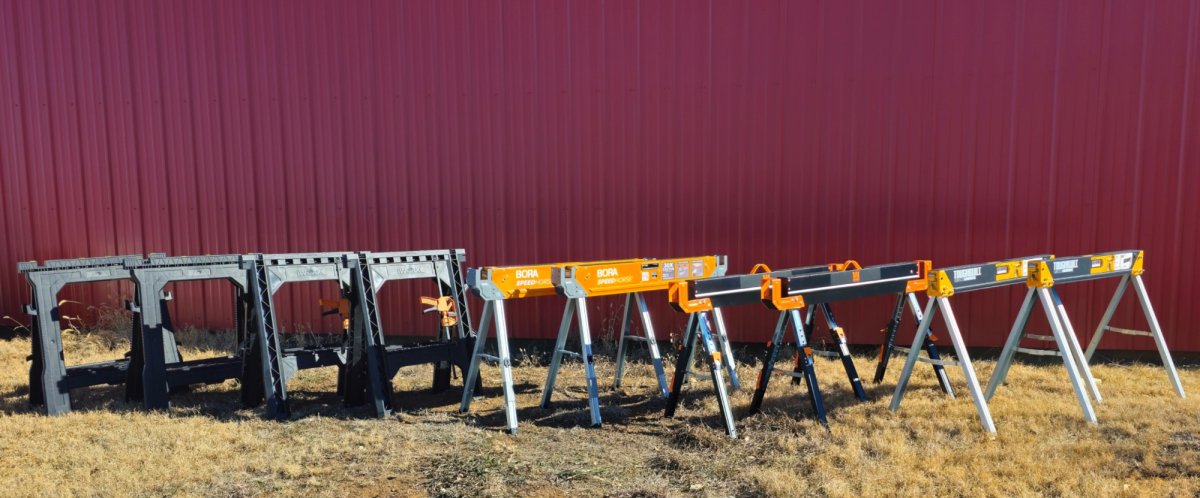
We may earn revenue from the products available on this page and participate in affiliate programs. Learn More ›
Limited workspace? A stable pair of sawhorses can transform any garage, driveway, or backyard into a fully functional workshop. After researching more than 25 sawhorses, we tested the top six options on real projects. One set stood out: the ToughBuilt C300, a sturdy pair that supports up to 2,200 pounds and has a non-slip surface for better material control.
At its core, a sawhorse is a simple tool—a crossbeam supported by A-frame legs, most often used in pairs to hold boards, planks, or panels at a comfortable working height. They offer cutting support and double as instant workbenches.
Choosing the right sawhorses depends on the projects you tackle. Read on for key shopping considerations and to see which models made the cut in our lineup of the best sawhorses.
- BEST OVERALL: ToughBuilt Heavy-Duty Folding Sawhorses
↓Jump to Review - BEST BANG FOR THE BUCK: Stanley Portable Folding Sawhors
↓Jump to Review - BEST SET: Bora Portamate Speedhorse Sawhorse Pair
↓Jump to Review - BEST LIGHT-DUTY: Worx Clamping Sawhorses With Bar Clamps
↓Jump to Review - MOST VERSATILE: Wen Folding Steel Sawhorse With 2×4 Support
↓Jump to Review - BEST WORKSTATION: Worx Pegasus Folding Work Table and Sawhorse
↓Jump to Review - BEST HEAVY-DUTY: DeWalt Adjustable Metal Legs Sawhorse
↓Jump to Review - BEST PORTABLE: Metabo HPT Folding Sawhorses
↓Jump to Review - UPGRADE PICK: Rockwell JawHorse Sheetmaster Portable Workstation
↓Jump to Review
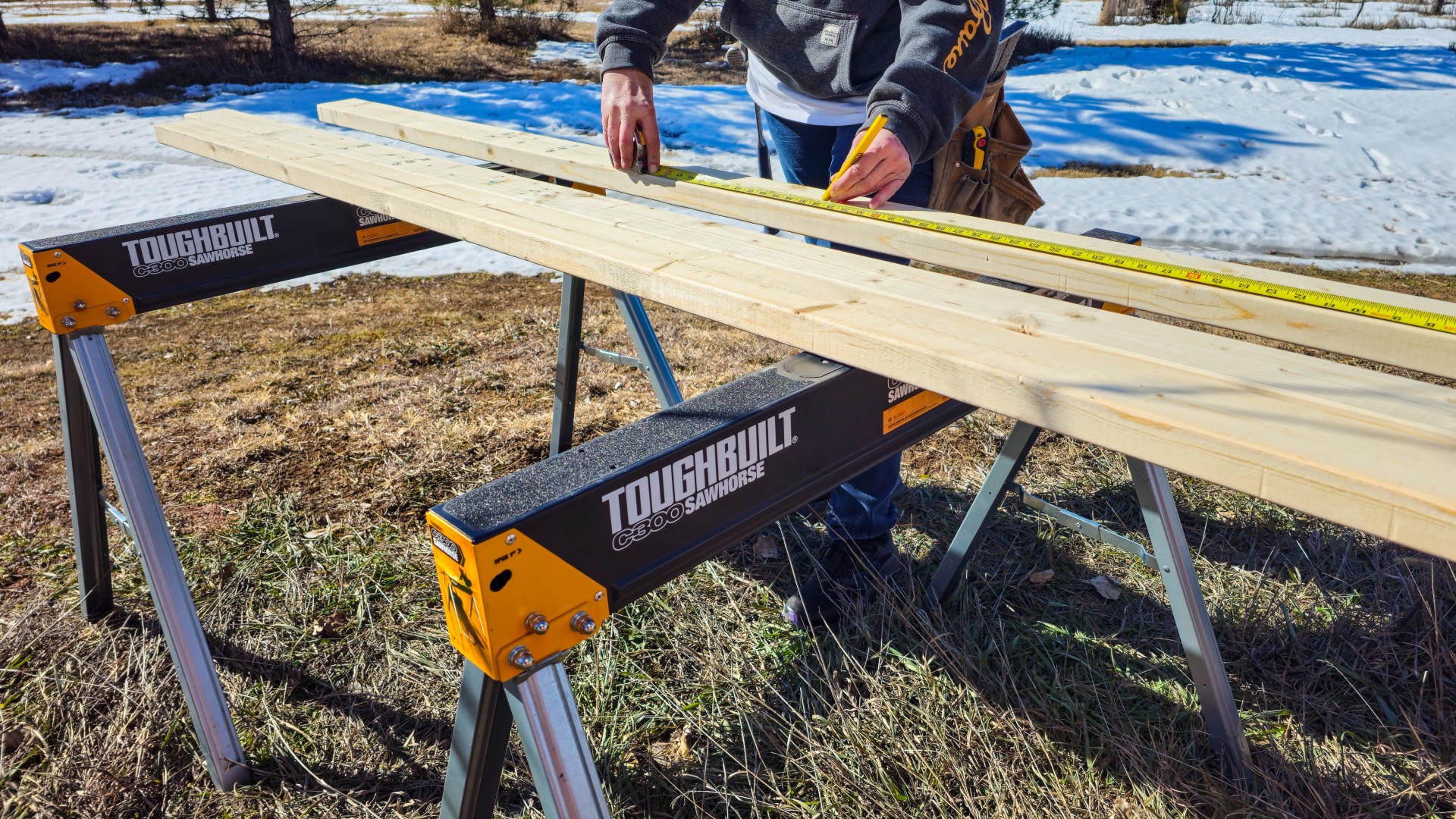
Sawhorses Comparison Chart
| Max Load Capacity(pair) | Height | Weight (each) | |
| ToughBuilt | 2,200 lbs. | 28.54″ | 11.13 lbs. |
| Stanley | 1,000 lbs. | 31″ | 6.2 lbs. |
| Bora Speedhorse | 1,800 lbs. | 33″ | 17.19 lbs. |
| Worx | 1,000 lbs. | 33″ | 17 lbs. |
| Wen | 2,600 lbs. | 24″ to 32″ | 20.5 lbs. |
| Worx Work Table | 1,000 lbs. | 32″ | 28 lbs. |
| DeWalt | 2,500 lbs. | 32″ to 39″ | 14 lbs. |
| Metabo HPT | 1,200 lbs. | 31″ | 5.5 lbs. |
| Rockwell JawHorse | 600 lbs. | 33″ | 38 lbs. |

Our Top Picks
Here you’ll find the 6 pairs of sawhorses that excelled in our hands-on tests. Plus, we’ve included three more models that made our shortlist but that we didn’t get a chance to test. No matter your project needs or budget, there’s something here for you.
Best Overall
ToughBuilt Heavy-Duty Folding Sawhorses
What We Like
- Provides excellent support
- Easy to store and transport
- Non-slip crossbar surface
- Quick and simple setup
What We Don’t Like
- Some may miss 2x lumber grooves
Specs
- Capacity 2,200 pounds (pair)
- Height 28.54 inches
- Weight 11.13 pounds each
Our Ratings: Ease of Use 5/5; Durability 5/5; Stability 4.5/5; Portability 5/5; Value 5/5
In a very ToughBuilt’s heavy-duty sawhorses are long-time favorites with contractors and DIYers, and for good reason. They combine stability, durability, and portability in a way that’s hard to beat. It takes a lot to impress us, but these sawhorses did exactly that.
The sawhorses have folding legs that stow neatly into their crossbars for easy storage and portability.
We liked the straps on the tops of each, which made carrying them easy. The legs were easy to unfold, and once set up, they were very sturdy. The ToughBuilt doesn’t come with grooves on the sides that hold 2x lumber, but we didn’t miss them.
The top of the crossbar is covered with a non-slip surface that held our material in place while cutting and sanding. The working height is 28.54 inches, which is slightly lower than most competing models, but we found that it made it easier to complete some of our tests, since we had more leverage over the power tools we were using. If you’re looking for an excellent set of sawhorses for everyday projects, you won’t go wrong with ToughBuilt.
What our tester says: “The ToughBuilt sawhorses are clear winners. I loved how easy they were to set up and their relatively low working height, which makes them extra stable for heavy-duty projects.” —Glenda Taylor, Product Reviews tester and writer
Get the ToughBuilt C300 Sawhorse at Amazon, Lowes, or Walmart.
Best Bang for the Buck
Stanley Portable Folding Sawhorses
What We Like
- Budget-friendly price
- Lightweight, durable, and sturdy
- Grooves for 2x lumber
- Surprisingly strong
What We Don’t Like
- Potential for pinched fingers
Specs
- Capacity 1,000 pounds (pair)
- Height 31 inches
- Weight 6.2 pounds each
Our Ratings: Ease of Use 4.5/5; Durability 4/5; Stability 4/5; Portability 4.5/5; Value 4.25/5
A good set of sawhorses doesn’t have to be expensive. Stanley’s pair of rubberized plastic models performed well in our tests; best of all, they come at an attractive price point.
While these are basic sawhorses, they feature 2x lumber grooves in the crossbars. The grooves aren’t especially deep, but they were sufficient for holding a couple of studs so we could place a plywood panel on top to create a secure workbench.
The setup was easy. We spread the legs apart and then pushed the interlocking braces down to lock the sawhorse in the open position. It’s best to use a foot to perform that task, as we ended up with pinched fingers when we pushed the braces down with our hands.
If you’re looking for a sturdy set of sawhorses on a budget, check these out. Don’t be misled by the fact they’re made from plastic; these are tough little sawhorses that stood up to all our tests.
Get the Stanley sawhorse (2-pack) at Amazon, The Home Depot, or ToolUp.
Best Set
Bora Portamate Speedhorse Sawhorse Pair
What We Like
- Lightning-fast setup
- Supports up to 1,800 pounds
- Solid, secure, and stable
What We Don’t Like
- Not the lightest option
Specs
- Capacity 1,800 pounds (pair)
- Height 33 inches
- Weight 17.19 pounds each
Our Ratings: Ease of Use 5/5; Durability 4.75/5; Stability 4.75/5; Portability 5/5; Value 4.75/5
Need a fast setup? Look no further than Bora’s Portamate Speedhorse. We got a kick out of being able to press a lever in the handle of the sawhorse and watch the folded legs drop into place. From there, it was effortless to lock the leg supports with a quick tap of a foot. Voila, instant sawhorse!
A set of Bora Portamate Speedhorses can support up to 1,800 pounds, which is more than most users will ever need. Our favorite perk was the ability to transform the sawhorses into a real working surface by using 2x lumber that fits in the grooves on each end and then placing a panel on top. Each of the crossbars comes with pre-drilled holes, and those can be used to attach a 2x board between the grooves for an even more stable work surface.
At 17.19 pounds, the Speedhorse is a bit heavier than some competing models. However, once set up, a pair of these sawhorses is very stable, and we wouldn’t hesitate to use them to create a miter saw table or to support other types of saws.
Get the Bora Speedhorse sawhorse at Amazon, The Home Depot, or Walmart.
Best Light-Duty
Worx Clamping Sawhorses With Bar Clamps
What We Like
- Onboard bar clamps
- Quick and easy setup
- Good pick for DIY projects
What We Don’t Like
- Lower load capacity
Specs
- Capacity 1,000 pounds (pair)
- Height 33 inches
- Weight 17 pounds each
Our Ratings: Ease of Use 4.5/5; Durability 4/5; Stability 4/5; Portability 4/5; Value 4.75/5
Worx sawhorses come with detachable bar clamps that work independently or slide into slots in the sawhorse in horizontal or vertical positions. We often find it necessary to clamp our projects to keep them from moving when cutting or sanding, but we don’t always have clamps handy. Worx solves this problem by including bar clamps on their sawhorses that stow directly on each unit.
The Worx sawhorses set up in much the same way the Stanley sawhorses do—we folded the legs out, pushed down on the interlocking braces to lock them into place, and then positioned our material on the top. This gave us a relatively stable surface, but we don’t suggest piling the maximum load of 1,000 pounds on top.
While not necessarily fragile, the somewhat thin plastic might be susceptible to damage from heavy impact. For our testing purposes, the Worx held up quite well, and we found them more than suitable for most DIY projects, including setting up a workbench for a miter saw.
What our tester says: “I love that Worx includes onboard bar clamps. Many sawhorse projects require stabilizing the material, and with clamps right on the tool, I don’t have to hunt for any.” —Glenda Taylor, Product Reviews tester and writer
Get the Worx sawhorses at Amazon, The Home Depot, or Walmart.
Most Versatile
Wen Folding Steel Sawhorse With 2×4 Support
What We Like
- Adjustable from 24 to 32 inches
- Deep 2x lumber grooves
- Non-slip crossbar surface
- Collapsible sawhorse for stowing
- Tall or small sawhorses
What We Don’t Like
- Tight leg storage
Specs
- Capacity 2,600 pounds (pair)
- Height 24 to 32 inches
- Weight 20.5 pounds each
Our Ratings: Ease of Use 4/5; Durability 5/5; Stability 5/5; Portability 4/5; Value 4.25/5
If you tackle a wide range of projects, DIY or pro, you may want to consider these Wen sawhorses, which can be adjusted as low as 24 inches or as high as 32. It took us a few minutes to get the hang of using the spring-loaded pins for adjusting the legs, but once we did, it became intuitive.
The 2x grooves on each end of the sawhorse are deep enough to hold entire 2x4s so there’s no need to screw down an additional board along the top of the crossbars, as is needed with the Bora Speedhorse. That’s a very handy setup, and one we wish all sawhorse manufacturers would copy.
The crossbars’ surface is non-slip and offers good traction for any width or length of material for cutting or sanding. The one issue we had—and it’s just a minor one—was that we had to pry pretty hard to get the folded legs out of the crossbar where they’re stored. We hope this will loosen up with repeated opening and closing, but throughout our testing, it remained pretty tight.
Overall, it’s a very durable folding leg sawhorse that is a good option for different types of projects.
Get the WEN sawhorse at Amazon, The Home Depot, or Lowes.
Best Workstation
Worx Pegasus Folding Work Table and Sawhorse
What We Like
- Clamps and bench dogs included
- Underneath shelf for tool storage
- Built-in handholds for carrying
What We Don’t Like
- Clamps occasionally pop loose
Specs
- Capacity 300 pounds as a worktable; 1,000 pounds as a sawhorse
- Height 32 inches
- Weight 28 pounds
Our Ratings: Ease of Use 4.5/5; Durability 4/5; Stability 4/5; Portability 4.5/5; Value 4.5/5
Talk about a workhorse! Worx’s ingenious design makes it the best sawhorse workbench combination we tested. The sawhorses support up to 1,000 pounds and feature a worktable top that supports up to 300 pounds. Just flip the 32-inch-high tabletop up for use and fold it down when you want to use the sawhorse.
We didn’t have a second Pegasus to use, but we did have another smaller Worx table that we linked with this one. The fact that the tables stayed securely together allowed us to work more confidently.
Made of heavy-duty plastic with a lightweight aluminum frame, this sturdy, durable tool provides everything needed for a simple garage workbench. It includes four clamp dogs and two quick clamps and has a handy little shelf for small tools. The whole thing folds up for easy storage or transport.
There’s one area where we felt slightly frustrated by the design. We don’t always need the squeeze clamps, and sometimes they pop off during setup. We think the issue could be solved using a small swivel to hold the clamps in place better. But overall, the Worx Pegasus is very well designed. Switching from a sturdy sawhorse to a convenient work table within just a few seconds makes it incredibly convenient.
Get the Worx table sawhorse at Amazon, The Home Depot, or Target.
More Great Options
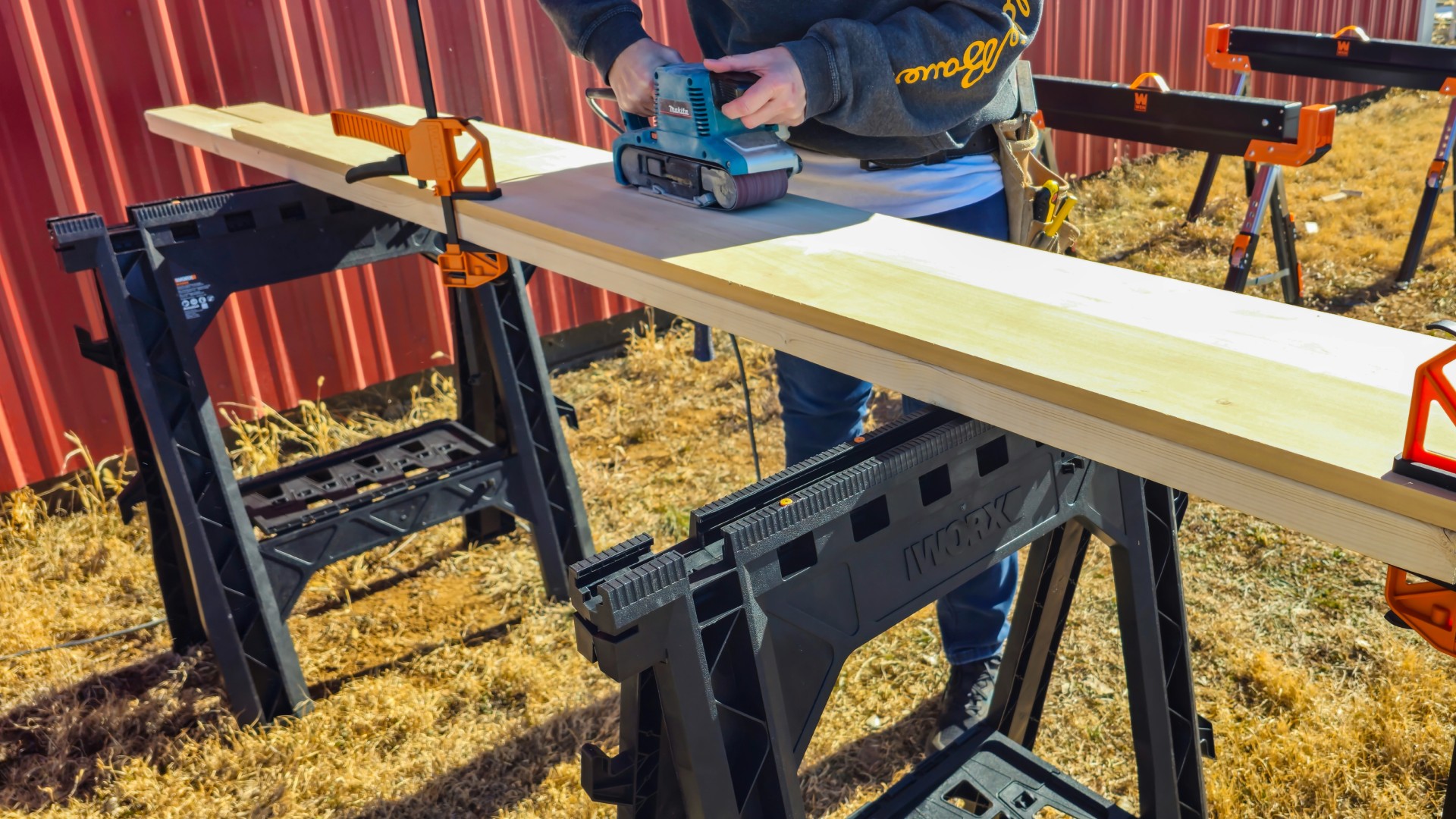
We didn’t personally test the next three sawhorses, but they made our shortlist due to their build quality, versatile features, and customer experience. If you still haven’t chosen a construction horse, one of these might be just what you’re looking for.
Best Heavy-Duty
DeWalt Adjustable Metal Legs Sawhorse
What We Like
- High weight capacity
- Independently adjustable legs
- V-groove for pipe handling
- Excellent woodworking horses
What We Don’t Like
- Plastic hinge is a potential weak point
- A pair is somewhat expensive
Specs
- Capacity 2,500 pounds (pair)
- Height 32 inches to 39 inches
- Weight 14 pounds each
We’re big DeWalt fans. Heavier duty than many of the other models on our list, these DeWalt sawhorses support a load capacity of up to 2,500 pounds per pair. Plastic and steel join forces in the construction of these sawhorses. Steel adds strength, while the rubberized feet provide a secure grip.
The plastic top of each sawhorse features slots for 2x4s and a V-groove for improved handling of pipe and tube. We like the independently-adjustable legs that compensate for uneven ground and provide a working height of 32 inches to 39 inches. The relatively lightweight 14-pound sawhorse also folds flat for easy carry and storage. We like this sawhorse for woodworking.
Get the DeWalt sawhorse at Amazon or The Home Depot.
Most Portable
Metabo HPT Folding Sawhorses
What We Like
- Light and easy to carry or store
- Sawbucks increase versatility
- Competitive price
What We Don’t Like
- Stability could be improved
- No height adjustment
Specs
- Capacity 1,200 pounds (pair)
- Height 31 inches
- Weight 5.5 pounds each
Metabo’s sawhorses provide another variation on a popular and effective design. We like that they combine a class-leading load-bearing capacity of 1,200 pounds with a fold-flat mechanism for portability and storage.
A top rail has slots for 2x4s and for easier handling of pipe. Two pairs of sawbucks, which slide into the top rail, add versatility to this common slot feature. In our years of experience, these are particularly handy for cross-cutting dimensioned lumber.
A cable tidy is molded into the legs to keep cords out of the way. Full-width hinges double as small tables. Our only criticism is the narrow leg spread; a wider stance would improve stability.
Get the Metabo sawhorse at Amazon, Lowes, or Walmart.
Upgrade Pick
Rockwell JawHorse Sheetmaster Portable Workstation
What We Like
- Supports 48-inch sheet material
- Stable on uneven surfaces
- Easy folding mechanism
What We Don’t Like
- Heavier than most, but has wheels
Specs
- Capacity 600 pounds
- Height 33 inches
- Weight 38 pounds
Rockwell’s JawHorse Sheetmaster Portable Workstation takes traditional sawhorses to the next level, and we’re all for that. A beast capable of clamping a full 4-by-8-foot sheet of plywood securely in place, it also holds onto unwieldy, oddly shaped objects like bicycles or furniture.
At 38 pounds, this one is heavier than some we tested but we like that it comes with wheels for tipping up and rolling, making it a good portable sawhorse.
With 10 times the clamping power of a regular vise, a 34-inch-high work surface, and a 600-pound weight capacity, the steel construction JawHorse makes for a brawny, capable, and reliable assistant—like an extra pair of hands, but better. While this isn’t going to be suitable for all traditional sawhorse uses, we would recommend it for someone who wants to secure their material with the Jawhorse’s strong clamping action.
Get the Jawhorse sawhorse at Amazon, The Home Depot, or Lowes.
Jump to Our Top Picks
How We Chose and Tested the Best Sawhorses
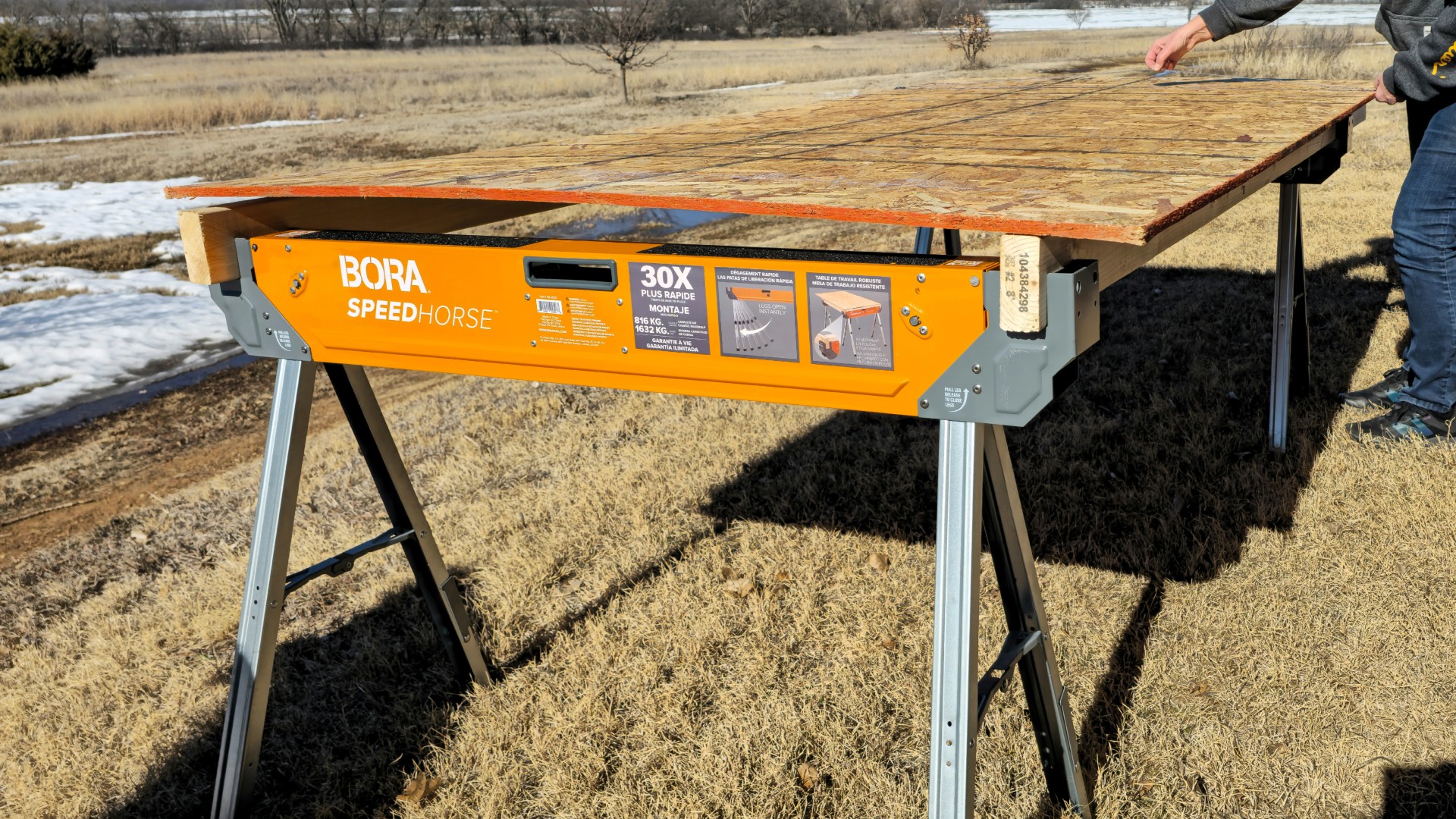
We carried out considerable research on over 25 best-selling sawhorses to ensure we were aware of all the latest developments before choosing the top 6 for testing in our own projects. We looked at several factors, including portability since sawhorses are often moved from site to site, along with build quality and value for the price.
In actual testing, we spent several days setting up the sawhorses and using them for common tasks, such as cutting lumber, sanding, and holding heavy items. We assessed each model for ease of use, durability, versatility, and stability. We tested hinges and locking mechanisms as well. We used a rubric and awarded points for each test and assessment. The better a sawhorse performed, the higher the points.
After testing, we averaged the points to determine our best overall pick and to categorize the others’ best uses.
| Products tested | 6 |
| Time spent testing | 4 days |
| Tests performed | 4 |
| Price range | $35 to $250 |
| Ease of Use | Durability | Stability | Portability | Value | |
| ToughBuilt | 5 | 5 | 4.5 | 5 | 5 |
| Stanley | 4.5 | 4 | 4 | 4.5 | 4.25 |
| Bora Speedhorse | 5 | 4.75 | 4.75 | 5 | 4.75 |
| Worx | 4.5 | 4 | 4 | 4 | 4.75 |
| Wen | 4 | 5 | 5 | 4 | 4.25 |
| Worx Work Table | 4.5 | 4 | 4 | 4.5 | 4.5 |
What to Consider When Choosing a Sawhorse
There are lots of factors to keep in mind when scoping out sawhorses. That includes features of the sawhorse itself, including material and design, but also the types of projects you’ll be working on.
Material
Sawhorses come in three materials: wood, metal, and plastic.
- Wood: The traditional sawhorse material, wood offers some advantages over other options, such as its durability and high capacity to bear weight. It’s unlikely to damage your saw if you accidentally strike the sawhorse with it. On the other hand, wood packs a lot of pounds, making it less popular than it once was for a sawhorse. Rarely do manufacturers make wooden sawhorses with adjustable or foldable legs for easy storage, but you can use sawhorse plans to make DIY sawhorses.
- Plastic: This is an excellent choice for those who only need a sawhorse for occasional lightweight projects, such as cutting plywood, painting, or to support a temporary worktable—though some are surprisingly heavy-duty. Typically lightweight, most plastic sawhorses fold for easy storage. Many come with clamps or small shelves to keep supplies in place and at hand while you work.
- Metal: These heavy-duty, durable sawhorses rank as a top choice among DIYers and professionals who rely on them extensively. Many feature adjustable legs and fold for storage. Some include clamps, vises, shelves, or drop-down sides for extra work space. On the downside, you may damage your saw if you accidentally strike a metal sawhorse with it. Left outdoors, steel sawhorses may succumb to rust.
Height and Leg Angle
Most sawhorses have a preset single height between 26 and 32 inches, which is perfect for an average-height user. Those that combine a worktop with sawhorse functions tend to reach a few inches taller. If you stand much taller or shorter than the average person, look for a sawhorse with adjustable legs that let you tailor the height to your comfort level.
Many projects that involve sawhorses use a lot of human energy that may rock the sawhorse back and forth and risk accidents. For that reason, leg angle is a key consideration. At the least, legs should sit at 15 degrees from the vertical. While this keeps the sawhorse relatively compact, more heavy-duty work may call for a wider angle up to 25 degrees.
Weight Capacity and Clamping Pressure
Sawhorse weight capacities range from 250 pounds to over 1,000 pounds. The average DIYer who enjoys woodworking or painting probably doesn’t require the maximum weight capacity. On the other hand, if you plan to cut large logs or other very heavy wooden pieces, consider a high-capacity sawhorse.
A built-in clamp on a sawhorse frees a hand that would otherwise have to steady the workpiece. Clamp designs and capabilities vary. Lightweight models with bar clamps exert a few hundred pounds of force. At the other end of the spectrum, vice-type clamps and heavy-duty foot-operated models apply in excess of 2,000 pounds of force.
Portability
If you want a sawhorse that easily travels, whether to the driveway, the backyard, or a work site, choose one with folding legs. Foldable legs also make a great choice for DIYers who only break out the sawhorse on rare occasions and keep it stored out of the way most of the time. Only need a pair of sawhorses to support a small worktable in your garage? Folding legs won’t be a key factor when making a choice.
Weight has a major impact on portability, and sawhorse material plays a big part in that. ABS or plastic sawhorses might only weigh 4 or 5 pounds each. A steel folding sawhorse, on the other hand, probably hits the 10- to 15-pound range. Heavy-duty models with high-capacity clamps can top 50 pounds. Though not particularly heavy, a 50-pound sawhorse could prove difficult to move around compared to lighter ones.
Additional Features
Finally, some sawhorses come with extra bells and whistles. Depending on your projects, you may want to consider sawhorses with:
- A small shelf to hold power tools, paint, and other accessories.
- Cord hooks to keep cords neat and out of the way.
- Steps built into the frame to serve as a stepladder.
- Small, built-in tabletops that combine a workbench and sawhorse in one handy tool.
Tips for Using a Sawhorse
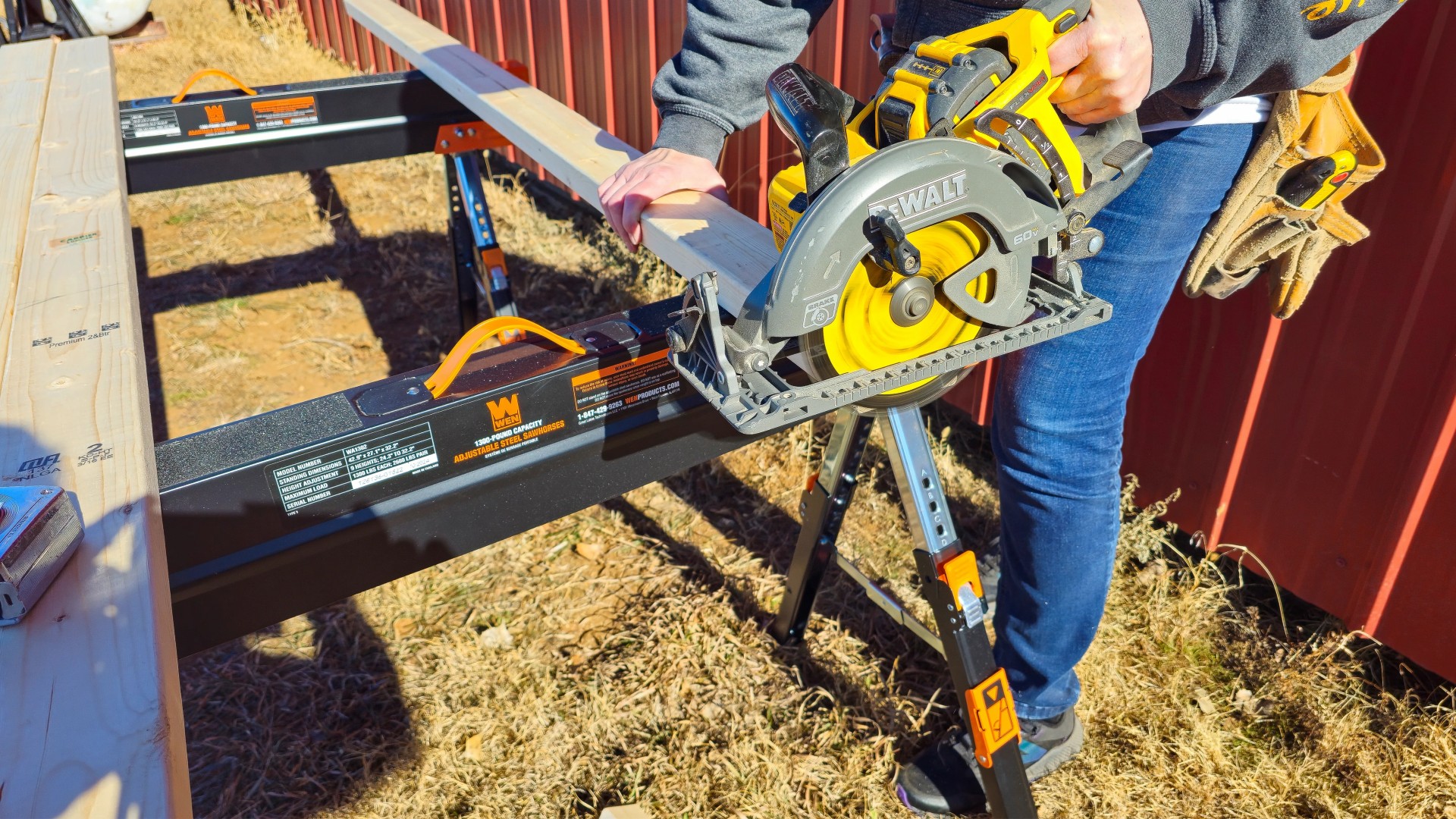
Stability ranks as the most important feature of a sawhorse, particularly with long material or large sheets. Unsteady sawhorses are a safety risk, whether they’re supporting lightweight lumber that could tip or used as a worktable while using a power saw.
- Always make sure the ground is firm and the sawhorses are spaced to provide adequate support.
- If you put a little sideways pressure on the material that is resting on the sawhorses and they rock, reposition them so that doesn’t happen. The same should be done if the material is sagging; find a good balance point.
- Material may hide the sawhorses, so make sure you know where you are cutting or you could damage the sawhorses or the saw blade. Some people fix sacrificial 2×4 or 2×6 wooden strips to the top of the sawhorses depending on their construction. These may be thrown away if damaged.
- Using a couple of 2x4s fixed along the edges of a sheet of plywood turns sawhorses into a temporary workbench. It may also be possible to make a shelf that fits between the legs (if not already provided), which gives workers somewhere handy to rest their tools while working.
- Consider drilling a hole big enough for a carabiner or cord hooks to keep your power tool cords off the ground.
- Heavy duty sawhorses also make effective barriers to keep people away from a work area.
FAQs
Sawhorses are often much more complex than simply providing support for a piece of lumber for cutting, sanding, or drilling. We hope our comprehensive explanation of available features has answered many of your questions. If not, below are our responses to other common queries.
A height between 26 inches and 32 inches suits most average people, but those taller than 6 feet might want something higher.
Anywhere between 15 and 25 degrees from the vertical provides a good, stable angle. The wider the angle, the more space the sawhorse takes up, but the more stability it provides.
With basic sawhorses, yes. Two sawhorses offer better workbench support, which helps keep material stable and level. It makes working more comfortable and helps to free up both hands. Heavy-duty models with a clamp to hold the material may work independently, but for large pieces, two units are still better than one.
Any kind of stable surface may suffice, such as a pair of solid boxes, strong wooden chairs, or tables. It’s important for both safety and working accuracy that the supports don’t move around or flex. However, it’s still best to use sawhorses whenever possible. If budget is an issue, building sawhorses on your own is also an option.
Many sawhorses fold for compact storage, and some of the newer models have collapsible legs that stow in the underside of the crossbar.
Absolutely! They offer a stable work surface for cutting, sanding, and more.
On adjustable models, like the Wen we tested, each leg adjusts independently. On fixed-height models, you can use shims under the legs if you’re working on uneven surfaces.
Meet the Tester
Glenda Taylor is a contractor, product tester, and writer focusing primarily on construction, DIY tools, and home appliances.
Additional research provided by Bob Beacham and Michelle Ullman


